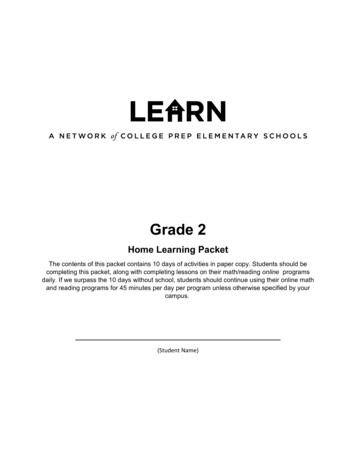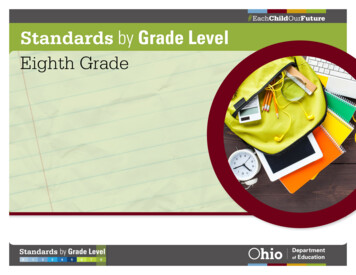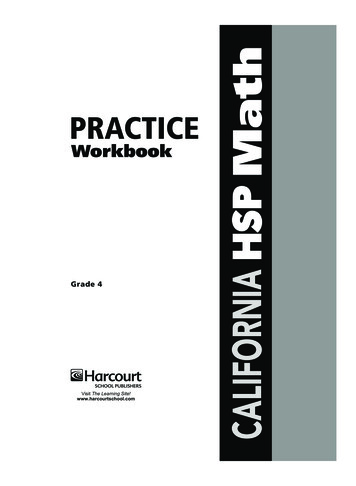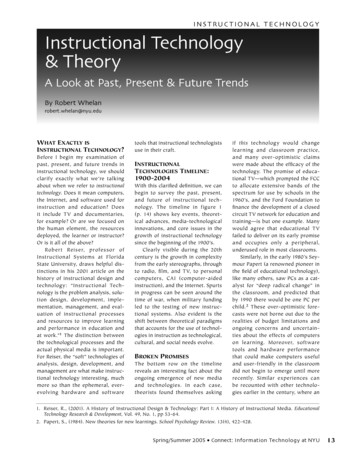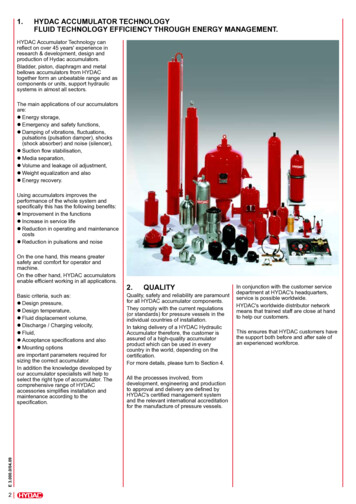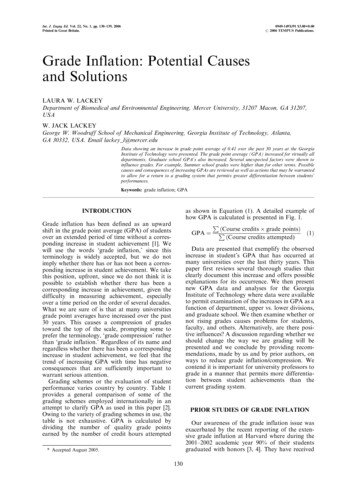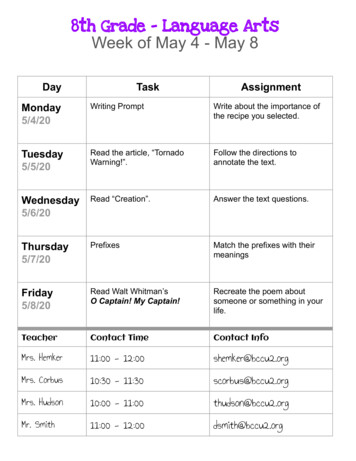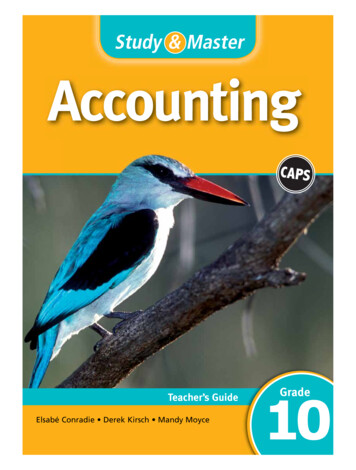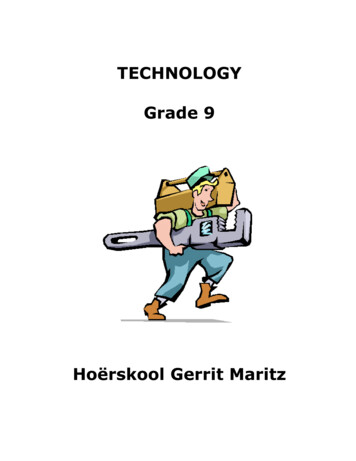
Transcription
TECHNOLOGYGrade 9Hoërskool Gerrit Maritz
CONTENTSSTRUCTURES.2Types of structures.2Functions of structures.2Structural members.3Properties of structures.4The design of structures.6Forces.7PROCESSING.10What is processing.10Materials.11Food processing.17Recycling.19MECHANISMS.24Mechanical systems.24Levers.25Moments.26Control mechanisms.28Gears.30Belt drives.33Pulleys.34Hydraulic and pneumatic systems.37ELECTRICITY.44Elektricity vs Electronics .44Elektronic systems.44Voltage and current.48Conductors and insulators.49Resistance.49Electronic components.50Logic functions.54TECHNICAL DRAWINGS.57Perspective.573-D drawing.61Isomectric and Oblique drawings.61Orthographic projection.67Dimensions.70Scale.701
StructuresTypes of StructuresNatural and Manmade structuresStructures are all around us, some are natural like eggshells, spider-webs, caves and treesand others are man-made like bridges, towers, houses, shopping bags and cups.Structures are further divided into three other groups namely frame, shell and massstructures:Frame StructuresA frame structure is a structure made upof many rigid parts joined together to forma ‘framework’. These different parts arecalled members.Shell StructuresA shell structure is moreenclosing than a frame structure - itsurrounds and encloses something.Solid/mass StructuresSolid structures rely heavily on solid construction such as masonryto support loads and to transfer these loads safely to the ground.Advantages of solid structures are that they are held in place bytheir own weight, losing small parts often has little effect on theoverall strength of the structure- Mountains, caves and coral reefs are natural mass structures- Sand castles, dams and brick walls are manufactured massstructuresFunctions of structuresSupporting a loadA structure must be able to support its own weight andthe load it has to carry. A load can be a person, anobject or a force. A moving load is known as a dynamicload. A stationary load is known as a static load.2
Enclosing people, animals or objectsAll containers fulfill this function, as well asmost buildings. Natural objects includeshells, caves, hollow tree trunks etc.Spanning a gapThe most common structure fulfillingthis function is a bridge. Bridges fulfillsanother function - supporting a load they have to carry their own weight andthe weight of whatever travels overthem.Structural membersColumns are vertical structural members.Beams are horizontal structuralmembers. Beams often spread aload across two or more columns.How well the beam works dependsthe material it is made from and itsshape. Beams used in largerstructures take many differentforms, some are simply solid, someare hollow, and others have specialcross-sections to provide strengthand rigidity.A cantilever is a structural member whichsticks out like an arm form the mainstructure. A cantilever is a beam which issupported at one end only.3
A buttress is a structure built against orprojecting from a wall which serves tosupport or reinforce the wall.A truss is a structure made up of triangles.ArchesThe load at the top of the key The ground around thestone makes each stone onabutments is squeezed andthe arch of the bridge press pushes back on theon the one next to it. Thisabutments.happens until the push isapplied to the end supports orabutments, which areenbedded in the ground.For every action there is anequal and opposite reaction.The ground which pushesback on the abutmentscreates a resistance which ispassed from stone to stone,until it is eventually pushingon the key stone which issupporting the load.Properties of StructuresStrength - the capacity to withstand forces that tend to break an object or change itsshape; it is an object's ability to hold its shape without collapsing.Rigidity - the ability not to buckle or distort.Stability - the capacity of an object to maintain or return toits original position; the state of being balanced in a fixed position.Why are some structures more stable than others?4
We say that a structure has high stability if, when it is loaded, it tends to return to, orremain in, the same position. The degree of stability depends on the relationship betweenthe base, the height and the weight of the structure.The weight of an object is due to the force of gravity pulling down vertically on the mass ofthe object. The invisible position of the mass through which the force of gravity pulls iscalled the centre of gravity. If the position of the centre of gravity is low and lies wellinside a large base area, the object is said to be very stable. If the centre of gravity liesto one side of the base area, the object is much less stable. If the centre of gravity isoutside the base area, the object is very unstable and may require further support. A tallobject tends to be unstable because its centre of gravity is in a very high position. Becauseof this, it can be more easily moved outside the base area by the application of externalloads. A structure is said to be stable when it will not topple over easily when acted uponby a force.Some rules for stability: A low centre of gravity.A wide base is generally more stable than a structure with narrow base. More weight at the bottom.It is not always possible to design structures that comply with these rules, and thereforesometimes special measures should be taken to make a structure stable. The tower craneis a long slender structure with a very thin base, and a very wide top. It has a large loadto carry at the top at one end of the arm as indicated in the previous picture. A counterweight is placed on the opposite side of the crane arm to that of the. This systemworks by balancing the load with that of the counter weight.GUYSStructures like high towers andtents can also be made stable byanchoring it to the ground withguys. Guys are ropes, cables orchains (flexible members) that holda structure firmly in place bypulling on it.guysStruts and TiesAll structures have forces acting on them. Ties, guys and strutsare structural members used to make structures stable. The partof the structure that has a tensile force acting on it is called a TIEand the part that has a compressive force acting on it is called aSTRUT.5
A tie (usually inflexible) holds other members in place bypulling on them. Many frame structures have memberscalled struts (always inflexible). Struts hold members inposition by pushing against them. Struts are made ofmaterials like wood or steel which do not bend.The design of structuresIf you look at some pictures of familiar frame structures like cranes, electricity pylons orroof supports you may notice that triangulation is used to make them rigid.Making Frame Structures RigidWhen forces are applied to By adding an extra bar orAn alternative to triangulationa simple four-sidedmember (usually a strut) corners is to use a gusset plate. Astructure it can be forced A and B are prevented fromgusset is simply a piece ofout of shape quite easily. Amoving apart. The structure then material used to brace andstructure which behaves in cannot be be forced out of shape, join the members in athis way is said to be non- and is said to be rigid. Noticestructure. A triangular gussetrigid.that the additional member has plate has been used here butformed two triangles in thethey can be made in a varietystructure.of shapes.Gussets are made of rigid materials such aswood or metal and is used to brace or holdframe members together.Framed structures achieve most of theirstrength and rigidity from the way they areassembled. Most frameworks are built usinga combination of struts and ties to maketriangles. Triangles make very strong andrigid structures. Using triangles in this way iscalled triangulation.Most shell structures achieve their strength andrigidity from the way they are shaped. Shellstructures very rarely have large flat surfacesthey tend to be designed and made with ribs to6
act as stiffeners. Egg and light bulbs containersare good examples. Both eggs and light bulbscan withstand considerable static forces if theyare applied carefully. The same principle is usedfor corrugated iron.Materials which are used to make structures can bereinforced by using it in a different position. If twostrips of are stuck to each other at a 90 angle, thecardboard will be stronger. The same happens towood when it is laminated. The strips of wood areglued together at an angle of 90 . A beam is alsostronger when it is used in an upright positionrather than flat.ForcesForces can be either static (stationary) ordynamic (moving).Static forces are usually forces caused bythe weight of the structure and anythingwhich is permanently attached to it.Dynamic forces are caused by things such as wind, waves, people, and vehicles. Dynamicforces are usually much greater than static forces and are very difficult to predict. Theseare the most common reason for structural failures.An external force is a force placed on the structure from outside, by the wind perhaps orperhaps by someone sitting or standing on it.Internal forces are the forces which the structure must provide within itself to resist theexternal forces placed upon it. If the external forces are greater than the internal forces, astructure will collapse.Forces acting on and within StructuresExternal forces or loads cause internal stresses to be set up in a structure. Not all forces orloads act in the same way. Forces can bend, pull, press, or twist. Each of these types offorce are given special names.Tension : Is a force whichtries to pull something apart.A structural member intension is called a tie. A tieCompression : Is a forcewhich tries to squashsomething together. Astructural member in7Bending : Bending is a wordyou will have met before. Astructure which is subjectedto bending is being stretched
resists tensile stress.compression is called a strut. and squashed at the sameA strut resists compressivetime.stress.Bending: A combination of forces that causes one part of a material to be in compressionand another part to be in tension. In this picture a sponge with lines drawn on it is bent.You can clearly see how the lines at the top are moved closer together (in compression)and the lines at the bottom is pulled apart (tension)Torsion : Is the name given to a turning or atwisting force.Shear : A shear force is created where twoopposite forces try to cut tear or ripsomething in two.Materials used in structuresThe properties of materials determine their function in structuresTensile strength: ability of a material to withstand pulling or tension forcesCompressive strength: ability of materials to withstand pushing or compressive forcesTorsional strength: ability of material to withstand being twisted or placed under torsionStiffness: how little distortion or deflection occurs when a material is placed underpressureHardness: Ability to withstand being scratched cut or dentedBrittleness: When material fractures with little or no deformationToughness: Resistance to impactDuctility: Allows a material to be elongated or stretched without breakingElasticity: When a material can be stretched out of shape, but it will go back to its oldshape when you remove the force.Flexibility: If a material bends easily and does not crack.Plasticity: When a material changes shape when you press or squash it, it will not goback to its old shape when you remove the force.8
Absorbent: Materials that suck up water easily.Waterproof: Materials that seems to push water away, it just runs of the materialCorrosion resistant: rust of UV-rays of the sunHeat resistant: will not burn or act as insulator against heat9
ProcessingWhat is processing?Processing changes a raw material into a manufactured product.A raw material is any material in its natural state. People process raw materials to changeor improve their properties. For example, at a fish factory the fish is skinned, cleaned andfrozen so that people can eat the fish long after it has been caught. Processing adapts rawmaterials to suit particular purposes. Materials can be galvanised, frozen, dried, painted,varnished or electroplated to improve their properties and to prolong their lifespan.Processing is important for the following reasons: Processing improves the properties of the materialProcessing increases the value of the materialProcessing creates many job opportunities.Raw materials and processed productsPeople make processed products from natural materials. For example, a concrete factorymakes concrete from stones, sand, cement and water. The natural, unprocessed materialsthat are used in processing are called raw materials. People use technology to convert anatural material into a processed product which is more useful. Processing usually takesplace in a factory. The manufacture of processed products often results in waste products,which can create many environmental challenges. During processing by-products are oftenformed.Primary, secondary and tertiary activitiesYou have learnt that raw materials are usually processed in a factory. This gives rise to theindustrial sector of our economy. The flow chart summarises the different types ofeconomic activities:Primary activitiesRaw materials are taken from theenvironment but left unprocessedExamples: Farming, fishing, forestrySecondary activitiesRaw materials are processed toimprove their propertiesExample: The process of milling maize to makemealiemeal is a secondary activity10
Tertiary activitiesTertiary activities include the provision of servicesExamples:Transport and communicationBanking and financial servicesEducation and medical servicesMaterialsNo substance, from metal to wood to food, will last forever. Many things can cuasesubstances to spoil, degrade or rot. People use their intelligence to find ways to prevent orslow down spoiling. Preserving is a response to the problem of spoiling. Many foodpreservation techniques were developed in the era before electricity and refrigeration, forexample:Biltong - salted and dried meat first used by the VoortrekkersBokkoms - salted and dried fish by the Cape Malay communityMopane worms - sun-dried by the Venda peopleWe will deal with several methods of preservation in this module, for example: how canwood, metal and food be preserved.WoodThere are two types of sawn wood.The terms hardwood and softwood do not refer to the wood, but to the leaves of the trees:Softwoods come from trees with needle-like leaves; the most common types are pine,spruce and larch. Hardwoods come from broad-leaved trees such as mahogany andmeranti. Not all hardwoods are hard - balsa is very soft.Solid woodsHardwoodsBalsa Ebony Mahogany Teak EucalyptusSoftwoodsCedar, PineManufactured boardsPlywood, laminated wood, chipboard, block board, hardboard, fibre board, soft boardPreserving WoodWood is an excellent natural product, but it can easily be damaged if not properly caredfor. Trees are vital components of the earth's ecosystem and are primarily responsible forconverting carbon dioxide into oxygen during photosynthesis. When wood is burnt orallowed to rot, the process is reversed:Carbon (from the wood) oxygen (from the air) CO211
Burning a tree undoes the entire life's work of the treesin only a few hours. Whenever atree is cut down. at least one indigenous tree should be planted as a replacement.Some exotic (foreign) trees come from wetter climates than ours and are water-wasters.Exotic trees, like the Black Wattle, often invade river and stream banks, reducing the flowof water. They should be removed. The Australian Blue Gum trees tend to be muchthirstier than our South African indigenous trees. Such trees should be replaced, especiallyin sensitive areas - like next to farmlands.When trees are cut down, the wood should be utilised for furniture, school desks and rooftrusses. Only smaller branches and bark should be used as firewood.DeforestationThe forests of the Amazon River in South America and on the islands of Indonesia arebeing felled at a mind-boggling rate. The high-quality wood is exported to the richernations of world, and local inhabitants reap very few benefits. These trees form the greenlungs of our planet. Removing them is causing the quantity of carbon dioxide in theatmosphere to rise, and this is a major cause of global warming.Remember that tropical forests take sixty years or more to mature. Temperate forests incooler lands grow more slowly and take twice as long. Parts of Africa are also being lootedfor timber. The wood is exported outside our continent.Trees are vital for the health of the planet and wood is a valuable commodity. Woodshould be treated with respect and protected.Although wood is classified as a renewable resource, trees grow too slowly. Careless orignorant people are cutting trees down at a faster rate than they can be replaced. We mustuse our resources in a responsible, intelligent and sustainable way.There are a number of important points to remember when protecting wood:The protective material used . . . should be easily absorbed by the wood must poison organisms that attack the wood, but be safe for humans and animals. should be readily obtainable locally must be cost effectiveThe protective material used should not . . . reduce the strenth of the wood cause metals to corrode (rust) for example nails and screws change or affect the surface of the wood make the wood more flammableMetalsAll metals fall into two categories. They can either be pure metals or alloys. A pure metalconsists of a single element, which means that it is a metal only having one type of atomin it. The most commonly used pure metals are aluminium, copper, iron, lead, zinc, tin,silver and gold.12
An alloy is a mixture of two or more pure elements. Pure metals sometimes lack certainrequired properties. To create these properties a number of these pure metals arecombined together.Pure aluminium is rarely used because it is too soft. It is normally mixed with other metals,which produce aluminium alloys that are even stronger than mild steel, are resistant tocorrosion but still retain the lightness of aluminium.Ferrous metalsFerrous metals are metals, which are mainly made of iron with small amounts of othermetals or elements added in order to give the correct properties. Almost all ferrous metalsare magnetic and can be picked up with a magnet. These metals rust or oxidise if nottreated as they contain iron.Type: Mild Steel, Cast Steel, Stainless steel, Cast Iron, Wrought ironNon-Ferrous metalsNon-Ferrous metals are those metals, which do not contain iron. These metals are notmagnetic and cannot be attracted by a magnet. Examples of these are aluminium, copper,lead, zinc and tin. These metals do not oxidise as they do not contain iron.Types: Silver, aluminium, copper, zinc, lead, tin, brass, bronze, titanium, magnesiumPreserving metalsIron is a metal that rusts easily by combining with oxygen in the air to form various ironoxides. Iron is the most widely used metal in industry, especially if it is alloyed to anothermetal to improve its strength or its resistance to corrosion. In 1889 the Eiffel Tower wasbuilt in Paris. This proved the abilities of iron in construction. It has become the mostwidely used material in high buildings.Iron can be painted, chromed, tinned, galvanised with zinc or even rubbed with oil. It canbe alloyed with chrome, vanadium, tungsten and titanium.A metal is a substance that conducts electricity and heat well. All metals are shiny - youmay have to clean off the oxide coating before you see the shine. They are malleable (canbe pressed into shapes) and ductile (can be stretched to form wire). Most metals have highmelting points (and even higher boiling points).Copper is used for most electric wire because it is an excellent conductor, and it does notrust (corrode) easily. It is also used for household objects.Gold and platinum are used in industry and jewellery because they do not rust at all.Platinum is used for jewellery and chemical catalysts. Gold is used for jewellery and verythin wires.Other useful metals are aluminium (for cans, aeroplane bodies, cooking foil, pots), iron (forcans, construction, tools, cutlery, steel wire, steel springs, cars, ships, and so on.) andlead (for plumbing).13
Some metals are alloyed (mixed) with the above-mentioned metals to improve theirproperties. For example: stainless steel is an alloy of chrome and iron tool steel is an alloy of vanadium and iron tungsten and iron gives a very hard steel for cutting tools and electric light bulbfilaments brass is an alloy of copper and zinc (used for brass door handles, hinges) bronze is an alloy of tin and copper (used for bronze for statues, machines partsand bearings).We saw earlier that iron rusts easily. Iron can be protected by coating it with paint, orwith another metal that does not rust as easily: tin on iron (tin cans), zinc on iron(galvanised iron roofing sheets, fencing wire, pipes). The protection is very effective ifundamaged. Once the metal coating has been damaged, the iron will begin to rust. Therate of the corrosion now will actually be faster than normal for uncoated iron.Galvanised ironThe main method of protecting iron from rusting is to coat it with zinc. This is so commonthat corrugated galvanised iron roofing sheets are often called zinc roofing sheets - this isnot accurate since the main metal is iron.There are different methods of coating iron with zinc:Galvanising can be done in several ways: Electroplating - using electric current to deposit zinc atom by atom. Hot dip coating - dipping iron into molten zinc. Sherardizing - covering the iron in zinc dust and baking it on in an oven. Spraying - applying molten zinc using a fine spray.Zinc is easier and cheaper to apply than chrome, nickel or tin.ElectroplatingThe piece of iron to be coated is placed in a bath containing a zinc salt solution - let us sayzinc chloride. The iron is connected to the negative pole of the battery. Another piece ofpure zinc is connected to the positive terminal of the battery and placed in the other end ofthe bath.We need a steady direct current (d.c.) with a low voltage. You will not need more than 6 Vto get satisfactory results. When the current flows through the solution, ions of zinc depositout of the solution onto the iron at the cathode' (the negative electrode).Electrolytic plating can be done with several metals. The shiny chrome on a motorcycle isfixed to the underlying metal using electrolysis.Before you can electroplate it, the object must be cleaned thoroughly. Wash the objectthoroughly, using an old toothbrush if it has a rough surface. Dip it into an acid solution vinegar will do if you leave it long enough. A smooth, polished object will give the bestresults.14
Hot dip galvanisingThis fast and effective method is widely used to galvanise iron on a large scale. The key toa good bond between the iron and the zinc is cleanliness. The process is as follows: Step 1: Degreasing - the iron is dipped into a hot caustic soda bath. This removes oil,organic materials and paint.Step 2: Pickling - the iron is immersed in acid to remove rust and dirt.Step 3: Rinsing - the iron is then washed to remove all traces of acid.Step 4: Heating - the iron is heated to a temperature of 455 C to 460 C.Step 5: Prefluxing - the hot iron is dipped into a solution of zinc ammonium chloride forfinal surface preparation.Step 6: Spelting - the hot iron is dipped into a bath of molten zinc.Step 7: Quenching - the hot coated iron is dipped into a zinc chromate solution to cooland to stabilise the surface to prevent early rusting.Composite materials:fibreglass, tyres, mud bricks, concretePlasticsThere are two main types of plastics and these arenamed Thermoplastics and Thermosetting Plastics.Thermosetting Plastics are made up of lines ofmolecules which are heavily cross linked. It creates arigid molecular structure. They may be heated the firsttime and shaped but they become permanently stiff andsolid. They cannot be reshaped again.Thermoplastics are made up of lines of moleculeswith few cross linkages. This allows them to softenwhen heated and to be bent into a variety of shapesand forms. They become stiff and solid again whencold. This process can be repeated many times.Examples of Thermoplastics are: PET, PE-HD, PVC, PELD, PP, PS-HD. This type of plastic is usually used forpackaging. The fact that it can be reheated andreshaped is ideal for packaging and recycling.Have you ever wondered about those little numbers inside a triangle of arrows on thebottom of plastic containers? They tell you the kind of plastic is used to manufacture thesoft drink bottles, laundry detergent packages, milk jugs, and other plastic bottles that youpurchase. The numbers and letters are intended as resin identification codes to facilitatethe recycling process. Plastic containers with the codes 1 and 2 are the easiest to recycle.15
Plastic identification codes16
Preserving foodsFrom the moment a ripe fruit or vegetable is pickled, or an animal is slaughtered for themeat, the food begins to spoil. So we must either use foods that are as fresh as possible,or we msut use some form of food technology to keep it as fresh as we can, for as long aspossible.Why does food degrade?Bacteria, yeasts, moulds and fungi are tiney living 'micro-organisms' that can spoil foodvery quickly. Chemical changes caused by enzymes (organic catalysts) soon affect thetaste, texture and look of foods. Oxygen from the air may react with chemicals in the foodleading to changes of colour, smell and flavour. Animals like insects and rodents causehuge losses in stored foods.Food poisoning is most often caused by bacteria like salmonella, botulinum, andStaphylococcus. Food poisoning may occur from one hour or even up to three days aftereating contaminated food. Symptoms include diarrhoea, nausea and vomiting, pains in theabdomen and fever.The deterioration can be slowed if we create conditions that the causes of degradation donot like. Fungi and bacteria do like warm, moist conditions which make them grow. Heatalso speeds up chemical processes. To fight them we just need to provide the cold and dryconditions that they do not like. In this way we are able to extend the shelf life of manyfoods.If we cut off the oxygen supply by vacuum packaging or by storing in a sealed containerwe reduce the bad effects of oxidation. Using insect-proof containers stops the destructionof stored foods by animals.Food processingMany of the foods you eat have been processed before you buy and eat them. Foodprocessing includes the treatment of food in a factory before it is sold. It also includesprocesses such as cooking, freezing or drying which may be performed at home. Somefoods are more highly proc
the arch of the bridge press on the one next to it. This happens until the push is applied to the end supports or abutments, which are enbedded in the ground. The ground around the abutments is squeezed and pushes back on the abutments. For every action there is an equal and opposit
